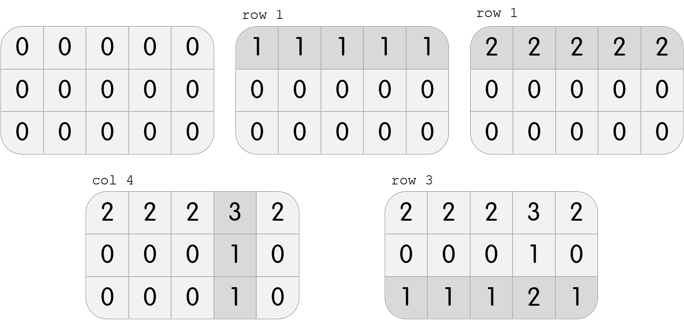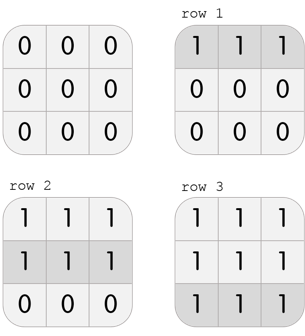On the way to school, Karen became fixated on the puzzle game on her phone!

The game is played as follows. In each level, you have a grid with n rows and m columns. Each cell originally contains the number 0.
One move consists of choosing one row or column, and adding 1 to all of the cells in that row or column.
To win the level, after all the moves, the number in the cell at the i-th row and j-th column should be equal to gi, j.
Karen is stuck on one level, and wants to know a way to beat this level using the minimum number of moves. Please, help her with this task!
The first line of input contains two integers, n and m (1 ≤ n, m ≤ 100), the number of rows and the number of columns in the grid, respectively.
The next n lines each contain m integers. In particular, the j-th integer in the i-th of these rows contains gi, j (0 ≤ gi, j ≤ 500).
If there is an error and it is actually not possible to beat the level, output a single integer -1.
Otherwise, on the first line, output a single integer k, the minimum number of moves necessary to beat the level.
The next k lines should each contain one of the following, describing the moves in the order they must be done:
- row x, (1 ≤ x ≤ n) describing a move of the form "choose the x-th row".
- col x, (1 ≤ x ≤ m) describing a move of the form "choose the x-th column".
If there are multiple optimal solutions, output any one of them.
3 5 2 2 2 3 2 0 0 0 1 0 1 1 1 2 1
4 row 1 row 1 col 4 row 3
3 3 0 0 0 0 1 0 0 0 0
-1
3 3 1 1 1 1 1 1 1 1 1
3 row 1 row 2 row 3
In the first test case, Karen has a grid with 3 rows and 5 columns. She can perform the following 4 moves to beat the level:

In the second test case, Karen has a grid with 3 rows and 3 columns. It is clear that it is impossible to beat the level; performing any move will create three 1s on the grid, but it is required to only have one 1 in the center.
In the third test case, Karen has a grid with 3 rows and 3 columns. She can perform the following 3 moves to beat the level:

Note that this is not the only solution; another solution, among others, is col 1, col 2, col 3.
————————————————————————————————————
题目的意思是给出一个全0矩阵,操作是在一行或一列全+1,问怎样才能得到给定矩阵
思路:从给定矩阵出发,每一行每一列能全减就贪心减去,根据行列数量决定先处理行还是列
#include <iostream>
#include <cstdio>
#include <cstring>
#include <string>
#include <algorithm>
#include <vector>
#include <queue>
#include <stack>
#include <map>
#include <set>
#include <cmath>
using namespace std;
#define LL long long
const int inf=0x7fffffff;
int mp[500][500];
struct node
{
int f,x,nu;
} ans[200000];
int n,m,cnt,tot;
void Row()
{
for(int i=0; i<m; i++)
{
int mn=inf;
for(int j=0; j<n; j++)
{
mn=min(mn,mp[i][j]);
}
for(int j=0; j<n; j++)
{
mp[i][j]-=mn;
}
if(mn>0)
{
tot+=mn;
ans[cnt].f=1;
ans[cnt].x=mn;
ans[cnt++].nu=i+1;
}
}
}
void Col()
{
for(int j=0; j<n; j++)
{
int mn=inf;
for(int i=0; i<m; i++)
{
mn=min(mn,mp[i][j]);
}
for(int i=0; i<m; i++)
{
mp[i][j]-=mn;
}
if(mn>0)
{
tot+=mn;
ans[cnt].f=2;
ans[cnt].x=mn;
ans[cnt++].nu=j+1;
}
}
}
int main()
{
scanf("%d%d",&m,&n);
for(int i=0; i<m; i++)
for(int j=0; j<n; j++)
scanf("%d",&mp[i][j]);
cnt=0;
tot=0;
if(m>n)
{
Col();
Row();
}
else
{
Row();
Col();
}
int flag=0;
for(int i=0; i<m; i++)
for(int j=0; j<n; j++)
{
if(mp[i][j]>0)
{
flag=1;
break;
}
if(flag)
break;
}
if(flag)
printf("-1\n");
else
{
printf("%d\n",tot);
for(int i=0; i<cnt; i++)
{
if(ans[i].f==1)
for(int j=0;j<ans[i].x;j++)
printf("row %d\n",ans[i].nu);
else
for(int j=0;j<ans[i].x;j++)
printf("col %d\n",ans[i].nu);
}
}
return 0;
} 游戏攻略:Karen的挑战
游戏攻略:Karen的挑战







 本文介绍了一款手机游戏中的挑战任务,玩家需通过选择行或列加值的方式,将初始为0的矩阵变为目标矩阵。文章提供了一个算法解决方案,包括如何通过贪心策略减少操作次数,最终达到目标配置。
本文介绍了一款手机游戏中的挑战任务,玩家需通过选择行或列加值的方式,将初始为0的矩阵变为目标矩阵。文章提供了一个算法解决方案,包括如何通过贪心策略减少操作次数,最终达到目标配置。
















 1036
1036

 被折叠的 条评论
为什么被折叠?
被折叠的 条评论
为什么被折叠?








